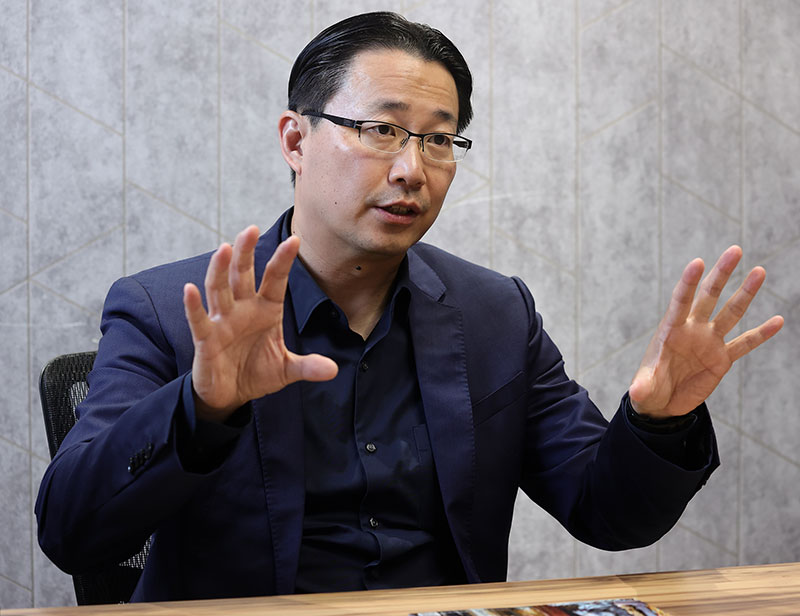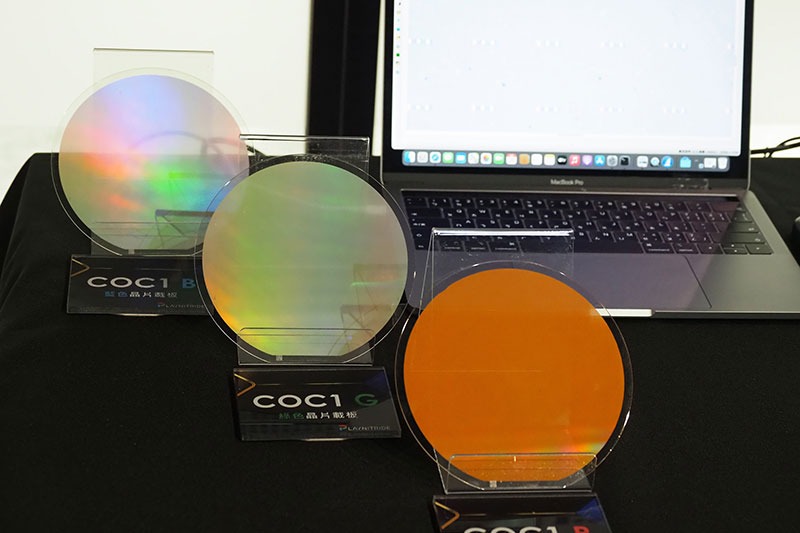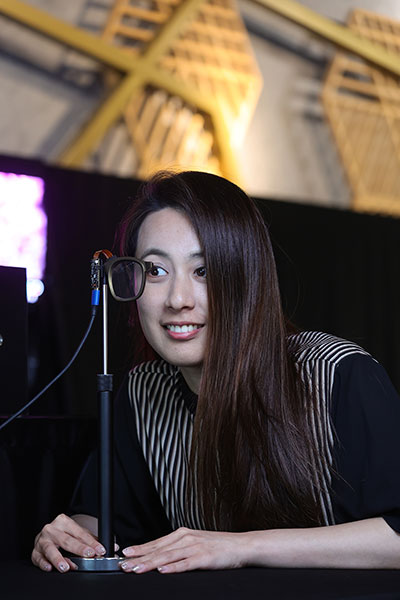
Lee Cheng-chung, president of the Taiwan Display Union Association, believes that Taiwan, as the only country with its own LED, display panel, and semiconductor industries, is in a strong position for the future.
Display devices are the most common and most direct form of man–machine interface. Taiwan not only ranks second worldwide in display production, it is also home to the world’s first micro LED production line. In fact, along with semiconductors, the display sector is one of the industries that best represent Taiwan’s industrial strength.
Imagine an eye-catching display, vibrant and colorful, that upon closer examination reveals itself to actually be a transparent panel. Or how about another screen full of brilliant colors, but formed into an S-shaped curve? These remarkable products are among the flagship offerings of PlayNitride, the first vendor in the world to bring “micro light-emitting diode” (micro LED) displays into volume production, and their displays can be viewed with full clarity even in direct sunlight thanks to their impressive brightness of 1,000 nits.
Micro LEDs are being called the next generation of display technology. Their exceptional brightness, vivid colors, and energy efficiency are already earning plaudits, and not only do they outperform current display technologies, they also provide tremendous flexibility in terms of size. Such displays can be as tiny as a 0.49-inch micro display for augmented reality glasses or as enormous as a 183-inch tiled video wall. This vast range of sizes promises near-limitless potential for a plethora of applications.
In addition to PlayNitride, Taiwan’s panel giants AUO and Innolux have also unveiled micro-LED-based smartwatches and smart car cabins this year, declaring 2023 “the year of micro LED mass-production” as they showcase the power and capabilities of these “Made in Taiwan” marvels.

Various applications of display technology
On the shoulders of giants
From bulky, heavy classic cathode-ray tubes to thin, lightweight, portable flat-panel displays such as liquid-crystal display (LCD) screens, the evolution of display devices has been a continuing visual revolution.
Seizing the opportunity presented by the booming laptop and desktop computer markets, Taiwan’s panel industry has experienced rapid growth. Thanks to the surge in consumer demand, the total output value of Taiwan’s panel industry reached NT$1.7 trillion as early as 2010, surpassing the trillion-dollar mark before the semiconductor industry.
Since 2015, panel makers in China have taken advantage of government subsidies and engaged in aggressive price-cutting to seize market share. As a result, the output value of Taiwan’s panel industry began to decline year on year, a downturn that continued until 2021. It was only then that the industry’s output value finally returned to its former glory, exceeding the old NT$1.7 trillion figure.
There is no “best,” only “better”
The Taiwanese display industry has made a remarkable comeback, says Lee Cheng-chung, deputy director of the Electronic and Optoelectronic System Research Laboratories at the Industrial Technology Research Institute (ITRI), who has dedicated a significant portion of his career to display technology. He believes that thanks to the government’s implementation since the 2010s of a series of programs in support of the display industry, as part of a long-term effort to promote the independent production of related materials and equipment and thereby to reduce reliance on imports, Taiwan now boasts the world’s most comprehensive display-sector supply chain.
To better compete with the Chinese supply chain, since 2016 Taiwan’s two leading panel manufacturers have been making adjustments to their operations, shifting their focus towards producing high-value products, implementing automated production, and using AI recognition systems to replace manual inspections. As the electronic components have become smaller and smaller, they have improved dust control and achieved higher photolithographic resolutions, resulting in better color saturation and image quality.
Both AUO and Innolux have seen the fruits of their efforts in Industry 4.0, automation, and smart manufacturing, obtaining Lighthouse Factory certification from the World Economic Forum. In response to the demand for remote work brought about by the Covid-19 pandemic, Taiwan’s panel makers have been raking in cash.
With their excellent quality and affordable prices, popular television brands such as Samsung and LG have made top Taiwanese producers like AUO and Innolux their go-tos. However, as Lee Cheng-chung remarks, “We can’t rest on our laurels. We are the unsung heroes behind these companies, but we can always do better.”

Charles Li, CEO of PlayNitride, believes that the success of their micro LED production line is not only due to technological breakthroughs, but also support from investors worldwide in terms of funding and direction.
The next frontier
In addition to computers and televisions, a new application—and new industrial battlefield—for LCD displays is emerging in the world of automotive interiors.
All newly manufactured cars today come equipped with a multitude of display panels, from the dashboard and center console to air conditioning controls, rearview mirrors, and even ones for the passenger seats. A vehicle may have as many as 12 panels, and this has created a booming market for automotive displays.
AUO and Innolux are major suppliers of such displays, with orders from leading car manufacturers around the world. Both companies produced some NT$70 billion in automotive displays in 2022, and Taiwanese panel manufacturers have become the preferred choice for major car makers worldwide for their quality and reliability in both materials and assembly.
A new technology
From 2010 to 2012, there was another significant shift in the industry, with South Korea’s focus on developing the advanced display technology known as organic LEDs (OLED). Over the course of a decade since then, they have successfully established themselves as leaders in the market, with a high market share. Today, however, Korean manufacturers are facing tough competition from Chinese counterparts who benefit from substantial government subsidies, resulting in lower prices for OLED products. Taiwan, too, faces the risk of being marginalized in this segment of the market.
But now another innovative display technology is emerging: micro LED. Big players in the industry like Apple and Samsung are eagerly investing in the development of this new technology.
Let’s start by explaining what micro LED is. It refers to the process of shrinking light-emitting diodes (LEDs) from sizes measured in millimeters down to mere micrometers, a.k.a microns (10-6 meters, μm), a thousand times smaller.
According to Charles Li, chairman and CEO of PlayNitride, in 2011 micro LEDs were still just a topic of academic research and it was considered “virtually impossible” that anyone could actually create them as viable products.
For comparison, the diameter of a single human hair is approximately 50–100 microns, and micro LED chips are typically sized below 30 microns, which is too small for the naked eye to distinguish (those used in augmented reality glasses are only 2.5 microns across). To create a 4K display requires over 26 million LED chips, each of which must be attached to a driving backplane. This might sound simple in principle, but at such small sizes it is a tremendous challenge.

Microscopic LED chips are transferred onto a temporary substrate to create chip-on-carrier (COC) boards.
The light at the end of the tunnel
The technology that has made this impossible feat possible is known as “mass transfer.” According to Li, every new technology has a “missing link,” and mass transfer was that link for micro LEDs. Mass transfer originated in the field of mechanical engineering, a field in which most people are not especially familiar with LEDs or display panels. This left micro LEDs in a no-man’s land at the intersection of panels, LEDs, and mechanical manufacturing.
Li adds that in the past, the main approach to mass transfer involved pressing together two very hard sheets of glass, but no matter how they did it, the yield rate (the percentage of product that meets quality requirements) was always an unacceptably low 70–80%. However, the team was inspired by the way that when applying a chop to a document, one gets a better imprint by laying another sheet of paper underneath it. By changing their approach and using a flexible underlay material, the yield rate increased to 90%.
First in the world
PlayNitride made the impossible possible by successfully establishing the world’s first micro LED production line, which started accepting orders and entered volume production in 2019. Through mass transfer technology, they are able to transfer large numbers of micro LED chips to the backplane, after which the display modules are tested and inspected, and defective LED chips are replaced. They have also created a seamless production process from LED wafer epitaxy to the finished micro LED panels. Currently, they are producing over a thousand chip-on-carrier (COC) boards per month, which are sold to major companies like Samsung and AUO, who are both shareholders and customers.
Currently, it remains the only production line in the world that is mass-producing COC boards, and Li estimates that they will be able to maintain this lead for at least two years.
Li confidently states that micro LEDs will undergo generational evolution just like semiconductors did, becoming ever smaller while panels grow ever larger. Furthermore, similar to Moore’s Law regarding semiconductors, the cost could be reduced by 50% every 12 to 18 months.

AR glasses have been called the “killer app” for micro LEDs, simultaneously bright, light, and fashionable.
A vibrant future
Li believes that micro LED presents an opportunity for Taiwan’s panel industry to leapfrog the OLED generation and directly enter a new era. This would allow Taiwan’s panel industry to regain its stature on the global stage.
“Micro LED is truly a gift from the gods to Taiwan. While it may be a challenging technology, once successfully developed it has the potential to dominate the market,” says Lee Cheng-chung, who is also the president of the Taiwan Display Union Association.
Lee further explains that the micro LED supply chain requires the collaboration of three industries: panel manufacturing, LED production, and a strong semiconductor industry. Taiwan is the only country in the world that possesses all three of these industries, making it the most capable nation in this field.
For Taiwan, which has been investing in micro LED technology for nearly a decade, this promises to usher in a new wave of display innovation, once again showcasing Taiwan’s prowess in the world of display technology.
For more pictures, please click 《Taiwan Takes the Lead—A New Era in Display Technology》











